Samsung Epic 4G Review: The Fastest Android Phone
by Anand Lal Shimpi on September 6, 2010 5:28 PM EST- Posted in
- Smartphones
- Samsung
- Epic 4G
- Gadgets
- Mobile
The Fastest GPU in a Smartphone
One thing I’ve learned over the past several years is that if you’re not the original manufacturer of something and are simply a glorified parts assembler, you generally have no clue how to do something right. There are obvious exceptions (Apple appears to be doing well), but this characterization applies to a lot of companies in the consumer electronics industry. They buy chips and parts from various suppliers, do a little bit of industrial design and generally don’t have the engineering know-how to deliver an optimized product into the marketplace.
Samsung is quite the opposite. Samsung is a DRAM manufacturer, a NAND flash manufacturer, and an application processor manufacturer. Samsung is responsible for the DRAM, NAND and silicon that goes into every iOS device sold by Apple. The company knows a thing or two about engineering.
The SoC inside the Epic 4G and other Galaxy S parts is called Hummingbird. It’s a 45nm SoC that implements a standard ARM Cortex A8 running at 1GHz and a PowerVR SGX 540 GPU. Despite Samsung’s experience in silicon manufacturing, it’s not much of an architecture/design company so we do see a lot of IP licensing within Hummingbird.
In this capacity Samsung is no different than TI, but what really sets Hummingbird apart is its GPU. Licensed from Imagination Technologies, the PowerVR SGX 540 is a significant improvement over the 530/535 in use in the iPhone, iPad and Motorola’s Droid X.
The SGX 530 has two USSE pipes and a single texturing unit. The 535 adds a second texturing unit, and the 540 adds another two USSE pipes. It’s unclear what clock speed the SGX 540 runs at inside Hummingbird, but I’d expect it’s somewhere near the 200MHz of the 535 in TI’s OMAP 3630.
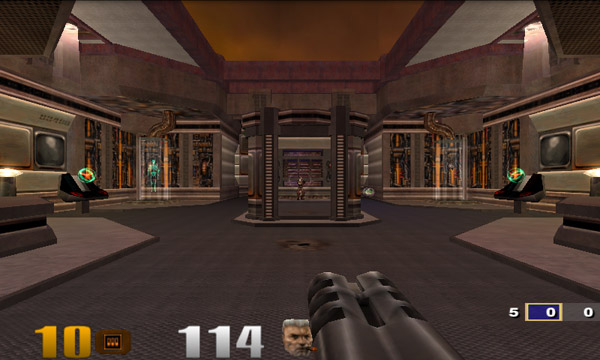
Quake 3 Arena running on the PowerVR SGX 540
The added execution hardware does incur a power penalty, however Imagination lists it as less than double the SGX 535.
The performance improvement is tangible. Samsung’s Hummingbird faster in 3D games/apps than any other SoC used in a smartphone today:
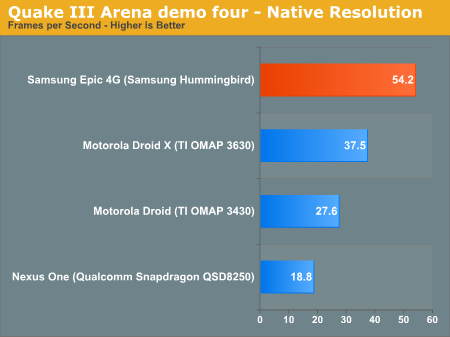
Under Quake III we saw a 44.5% increase in performance over the Droid X. Compared to Qualcomm's Snapdragon, performance improves by nearly 2x.
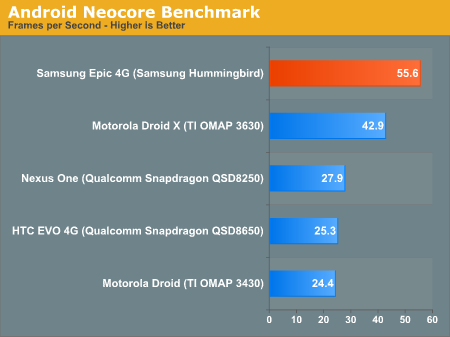
Even in Qualcomm's own 3D test, the PowerVR SGX 540 is more than twice as fast as the Snapdragon. We see a 30% performance advantage over the OMAP 3630. I'd expect to see about the same advantage over Apple's A4.
Unfortunately for Samsung, 3D gaming hasn’t really taken off on Android as a platform. The best examples of what’s to come are what we’ve seen from Epic and id, but both of those demos were done on iOS (although I suspect Android versions would hit at some point) and we’re still pretty far away from having actual games based on those engines on mobile phones.
While the SGX 540 could be responsible for the Epic 4G’s smoother than expected UI, it’s mostly a waste of hardware today. Clearly you don’t need this powerful of a GPU to make scrolling through menus smooth. Perhaps Samsung has grand plans for Hummingbird or simply wanted to outdo the competition on paper. Higher resolution products due out in the future will demand faster GPUs (think tablets) so it’s possible that Hummingbird wasn’t specifically targeted for an 800 x 480 smartphone.
General CPU performance is comparable to the OMAP 3630 and what you’d expect from a 1GHz Cortex A8. The 45nm SoC should sip power but it’s unclear what Samsung is doing for power management on the SoC itself. While both Hummingbird and Apple’s A4 are manufactured at the same fab at 45nm and both use the Cortex A8, there’s a lot more to determine the total power consumption of an SoC.

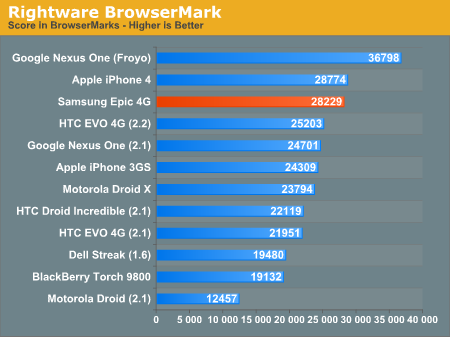
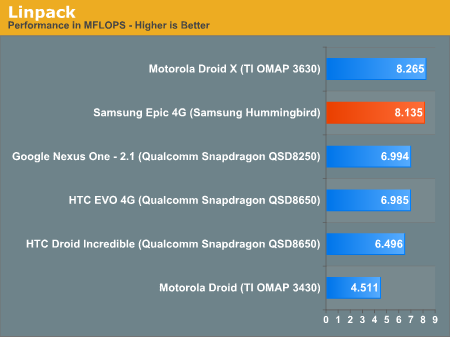
Hummingbird’s memory bus is likely a 32-bit single channel LPDDR1 interface, but overall I’d say it’s safe to say that this is the fastest SoC currently shipping in a smartphone. Apple’s A4 used in the iPhone doesn’t run at 1GHz, and TI’s OMAP3630 uses the PowerVR SGX 530 compared to Samsung’s SGX 540. Unfortunately much of the performance advantage will go unused as 3D gaming simply isn’t that prevalent on Android phones today.










93 Comments
View All Comments
dk99 - Tuesday, September 7, 2010 - link
Why is it so easy to see the pixels on the epic's screen? It seems annoying.Look at the first picture on the display page on Anand's article.
http://images.anandtech.com/reviews/gadgets/Samsun...
Anand Lal Shimpi - Tuesday, September 7, 2010 - link
The camera/lighting plus running the screen at full brightness exaggerates pixel pitch a bit but remember this device has the same resolution as the Nexus One but with a larger screen.Take care,
Anand
dk99 - Tuesday, September 7, 2010 - link
I had a chance to check out an Epic 4g at the local sprint store and compared it to the Evo screen. The pixels were more easily seen on the Epic and it did bother me, but I guess it may not bother others as much.Here is a picture from another review site demonstrating the pixels:
http://www.mobilecrunch.com/wp-content/uploads/201...
Anand, Thank you for a great website.
Aigoo - Tuesday, September 7, 2010 - link
Pentile RGBGhttp://en.wikipedia.org/wiki/PenTile_matrix_family
:(
pvdw - Tuesday, September 7, 2010 - link
You mention the problem with jerkiness on Android phones, but I find my Desire is wonderfully smooth. It's almost exactly the same hardware as the Incredible, but with better build quality, and I've found no SMS scrolling problems.My Desire is unbranded, so there's no junk from operators like Sprint, etc. installed. Maybe this makes a difference?
And I manage to easily get a days worth of business use out of it - remote access, phone calls, web, etc. 30 hrs on lighter use.
I sure would love to have a better gpu, like the Galaxy S, and, more importantly, a screen that I can see in daylight without squinting.
joncat - Tuesday, September 7, 2010 - link
I wouldn't say that the SGX 540 is a waste of hardware today. While there are nowhere near the amount of 3d games that IOS has, there are several high quality titles that run great on the galaxy s. Need for Speed Shift and the Sims 3 HD by EA, NOVA, Sandstorm, Assasin's Creed, Hero of Sparta, Asphalt5, to name a few by Gameloft all run great at native resolution, which can't be said for phones like the EVO and Incredible that run on the Snapdragon SOC.Mumrik - Tuesday, September 7, 2010 - link
I absolutely love that we're back to using Quake 3 as a GPU performance benchmark.It stuck around for a long ass time in the first place and now it's back :-D
Mumrik - Tuesday, September 7, 2010 - link
Anand, is there a reason you don't test standby battery life?It's a pretty essential number...
Even if it prevents you from getting the review up fast, you could always just post the review and add the data later after averaging out 2-3 tests.
SomeAudioGuy - Tuesday, September 7, 2010 - link
Ok, so I've had an Epic 4G for about three weeks now. Battery life is completely on par for any other smartphone in this segment.I did switch my background to a darker one (the tent with star trails), but other than that I've done very little to mod the device. I don't even use ATK or juicedefender, and I use the built in auto backlight setting to manage brightness. I did not use any 4G today.
I pulled the phone off my charger at 7am, it's 4pm now. I streamed two hours of Pandora, made one 30 minute phone call and three 5 minute phone calls. Took three pictures and uploaded them to twitpic, have been using Tuiteur, facebook, and checking email on 4 different gmail accounts (with background sync enabled). Spent five minutes yelping a spot for lunch. Played about 15 minutes worth of games (GalCon Flight Control, and Simple Dice), helped debug a wireless router (which required about 20 minutes of wi-fi use), and just spent the last 5 minutes looking up geocaches in my area.
My battery is at 35%.
I would term my use as "moderate".
There's absolutely nothing wrong with the battery life on the Epic 4G. Nothing at all for a phone this powerful and with a screen this large.
GPS is a pain, but I find if I turn off GPS throughout the day, and turn it back on before I start an app that requires GPS, i get locks fast enough, and I'm usually down to about 3 meters accurate.
Maybe it's just the signal in Anand's area, but I've gotten better battery life with both EVO and Epic, and even though we TECHNICALLY don't get 4G in LA, when you find pockets of 4G access we're currently getting 4+Mbps down.
Lastly if you're going to review a keyboard slider phone, maybe give the phone to someone who isn't quite so lit on iPhones, and likes to use a hardware keyboard? Just a thought? Exactly TWO sentences are spent on what is quite possibly one of the best keyboards on the market today. No small feat considering this is NOT an HTC phone. No mention of the dedicated number row (who really likes pushing a function key)? No comparison to any other hardware keyboards? Really? Nothing?
Dane74 - Wednesday, September 8, 2010 - link
not ot call BS, on your GPS findings butt eh are out of wahck with all the testing using testing applicaitons. There are several serious problems with Epics GPS. And actually a number of them show up becasue of switching the GPS off. Go to XDA, or androidforums and you will see discussions.'
Your 3 meters accurate is Epic fooling you since it has already been shown the Epic is cooking those numbers..
Look at the pictures published by anantech, or others. Pictures of side by side comparisons showing nubmer of satellites used by the Epic show the serious problem.